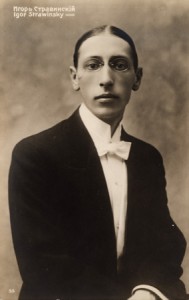Here’s how shocking becomes NOT shocking:
Ninety-seven years ago today, a ballet created by the Russian composer Igor Stravinsky was unleashed to an unsuspecting Parisian audience. The French audience was used to ballets like Swan Lake, Sleeping Beauty, and The Nutcracker Suite—music described as elegant and beautiful. Rite of Spring sounded nothing like those other ballets. Stravinsky’s “new sound” was NOT well received. Here’s what happened:
When the curtain rose and the dancing began, there appeared a musical theme without a melody, only a loud, pulsating, dissonant chord with jarring, irregular accents. The audience responded to the ballet with such a din of hisses and catcalls that the performers could barely hear each other. (from the Internet)
At first the audience laughed, then booed, then shouted their disapproval. Then members of the audience shouted its disapproval to other members of the audience. Some spit on each other. Little old ladies smacked people with their canes. With more music came more anger, which became brawling. Blood was drawn. Rioting ensued. The police were called. People screamed rushing for the doors to get out.

Even the composer Stravinsky, mortified at the audience’s reaction, fled the theatre.
The amazing part: All of this “madness” took place within three minutes of hearing the unusual ballet.
Q: What the heck happened?
A: Brain physiology and brain chemistry.
The brain doesn’t like “new stuff.” I shouldn’t say “doesn’t like” as much as “can’t process” new stuff.
Sound is presented from the ear to the brain (auditory cortex) as an electrical current. When sound has a rhythmic meter and sounds familiar, the brain likes it. It elicits a response that makes us feel comfortable.
If the meter is jagged, irregular, unexpected, and strange, it makes us feel uncomfortable.
Here’s how the Rite of Spring music was described:
“…aggressive, sometimes chaotic, harsh, savage, even brutal. Harmonies clash, rhythm is disjunct, meter constantly changes, instruments playing out of their register, and on and on. The listener has virtually no ability to predict what the music will do next…”
When the brain hears dissonant music, neurons run around trying to understand it. The brain searches to find a pattern. This activity causes the neurochemical dopamine to be released. A little dopamine causes euphoria. Too much dopamine causes schizophrenia.
Neuroscientists explain the Rite of Spring Riot as a neuron revolt—causing dopamine-induced temporary insanity on the part of the audience.
After the performance, Stravinsky was vilified as an “iconoclast out to destroy all the most sacred canons of musical aesthetics and grammar.” The music was considered scandalous. It also changed musical history.
How? Because of another amazing thing about the brain: neuroplasticity. The brain can adapt. (BTW, that’s true for any age.) You can get used to anything. This “shocking” music became beloved. How long did it take? A little less than a year.
In March 1914 Stravinsky returned to Paris to play the same music (but not perform the ballet portion). People were aware what to expect. This time they heard the same music differently. They were able to detect the patterns and order hidden in the “noise.” Stravinsky became a hero! And also one of the most influential composers of the 20th century.
Rite of Spring became so popular that in 1940 Walt Disney bought the rights to it to use in a children’s animated feature: Fantasia.
To me the moral of this story is: At first the brain wants to reject “the new.” It tries to assimilate this new experience into an old one—causing brain friction. But give it enough time, and the brain will embrace it. What was painful before now becomes a source of pleasure. Shocking becomes NOT shocking. You can actually change your biology. Very cool.
I remember the first time I heard punk rock—from a band called X. I thought, “Whooaa, this is radical stuff!” It was jarring, kind of unnerving to me—sounded like non-melodic one-note yelling. Then the more I listened to X the more I liked the music and ended up a big fan of the group. And now when I listen to that “radical” music from the 80s, it sounds downright quaint.
A few years ago I had a “dopamine overload” experience—listening to a performance of Kronos at the Santa Cruz Civic Auditorium. I thought I was going to be hearing pleasant chamber music from this group (two violins, one viola, and one cello.) Except this concert was called “Experimental Music” and one of the musicians brought a theremin.
HIDEOUS best describes the songs. They were unnatural sounding to me. Even when I hear raccoons fighting outside my bedroom window late at night, at least it sounds like part of nature. But this Kronos concert was like “Gort! Klatu barada nikto” to my ears.
The first song made me irritable. The second song made me mad I dressed up, spent money, and wasted my time. I thought, “I put on a vintage hat for this!”
The third song made me wish I had a cane so I could bash somebody. By the time the fourth song had started, I was climbing over people running for the exit!
If I ever run into a Kronos person, I am going to demand my money back and say, “Sorry, but you are NO Stravinsky!”

I like this, some things about Stravinsky that I didn’t know. I look forward to roaming back through your blogs.
HUGZ
Marci
The last few months, I’ve been working on an animated graphical score of Stravinsky’s Rite of Spring. As of yesterday, it is complete:
Part 1: http://www.youtube.com/watch?v=02tkp6eeh40
Part 2: http://www.youtube.com/watch?v=Q2y90hH4H7Q
Enjoy!
Stephen Malinowski
Music Animation Machine
stephenmalinowski.com